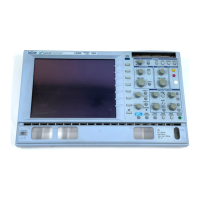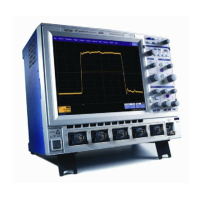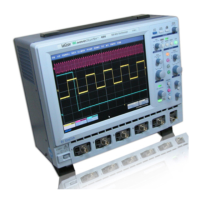X-Stream Operator’s Manual
WM-OM-E Rev I 373
the time the channel sampled the head signal. If the "+" signs are all very close to the waveform, the
signal is good. If the "+" signs are not close to the waveform, the signal may not be good. The ML
markers do not appear if more than 500 are needed on the display. If they are on but not visible,
zoom in on the head signal.
Additionally, you can turn on Level Markers, horizontal lines that show the expected levels at the
center of the screen.
The ML markers do not appear if more than 50 are needed on the display; if they are on but not
visible, they can be zoomed.
The Channel Emulation without reference method can be used either on newly acquired channel
data or data previously saved in a memory. The following information is required:
• Head Signal: The VCO Synchronization field is needed at the beginning of the area to
be analyzed. If the VCO Synch field is not found, Channel Emulation without reference
will not be able to analyze the signal.
• Signal Type: Specifies the type of PRML channel.
• VCO Synch Pattern: In a normally operating disk drive, every time Read Gate goes
true (at the beginning of every segment to be read) there must be a repetitive signal
called the VCO Synch. It is required for adjustment of the phase of the PLL (phase
locked loop), which generates the sampling clock, as well as adjustment of the AGC
(automatic gain control). Most commonly, the VCO Synch is 2T (a transition every
other bit cell).
• Bit Cell Time is used as a starting estimate of the VCO Synch signal. If the value is not
known and the VCO Synch field is at the beginning of the area to be analyzed, touching
the Measure Bit Cell Time button will determine it automatically.
• Ignore Last <n> Samples: Specifies the amount of ‘garbage’ data to ignore after the
end of the written data and before Read Gate goes false.
• SAM Threshold: This is the user-specified threshold used by Channel Emulation
without Reference to decide when to record an error. SAM is the difference in mean
squared distance between the samples observed from the sequence of samples
decided upon as the likely sequence and the one discarded at that decision point. See
Note 1 below.
• Run Length Limit (k): If RLL encoding is set to zero, no check is made and Channel
Emulation without Reference only reports errors due to difficulty deciding on a
sequence of samples (small SAM). If set to a non-zero value, it specifies the number of
permitted non-transitions in a row. See Note 2 below.
• Adjacent Transitions: Corresponds to the "d" in RLL code specified as m/n(d,k). See
Note 3 below.
Additionally, these parameters are useful (though not essential) for Channel Emulation without
reference:
• Read Gate: If the Read Gate signal is connected to a DDA channel and specified, it will
be used to determine the regions of the signal to be analyzed. Since the VCO Synch
